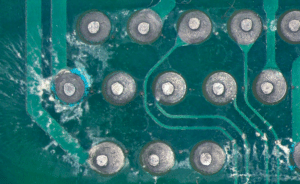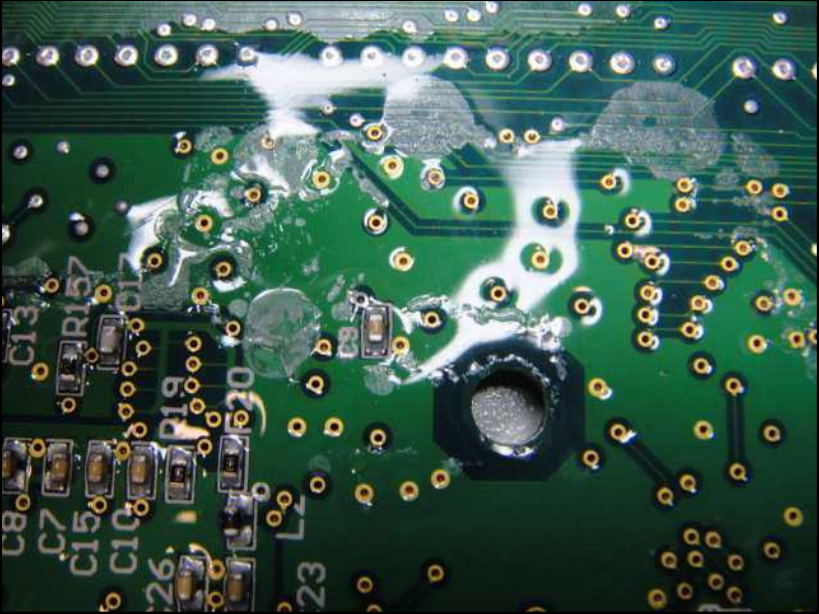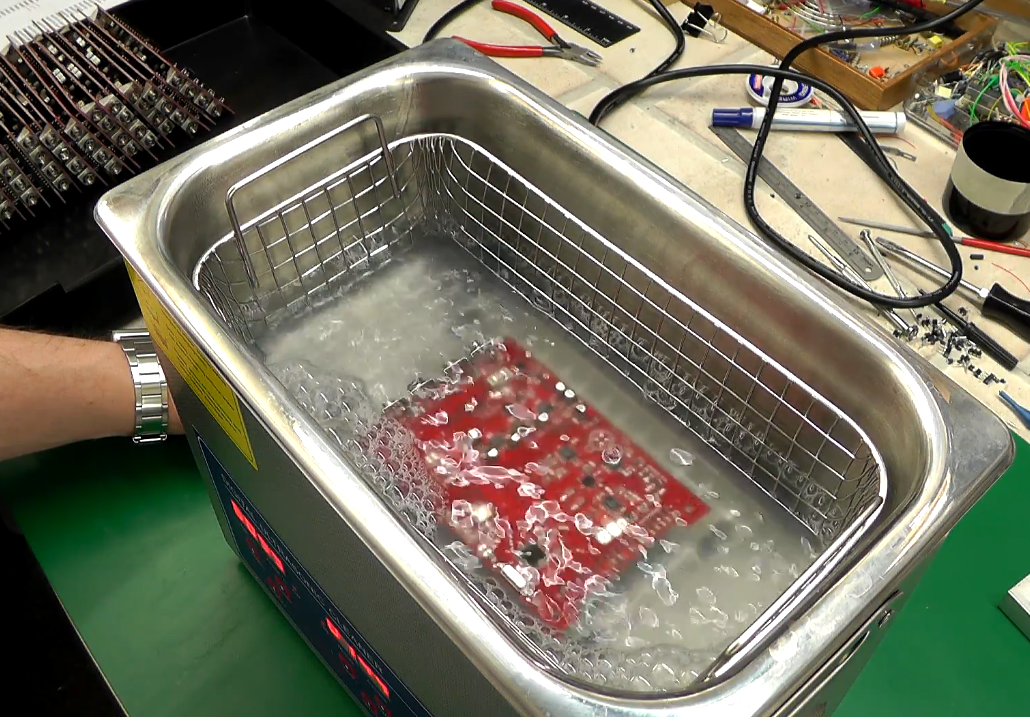Are you using 'no-clean' flux in your PCB assembly process, thinking it means you can skip the cleaning step? Think again. Despite its name, no-clean flux can leave behind residues that cause serious issues like electrical failures, poor conformal coating adhesion, and long-term reliability problems. In this detailed guide, we'll uncover the hidden risks of no-clean flux residue and why cleaning is still crucial for high-quality printed circuit boards (PCBs). We'll dive into no-clean flux residue problems, effective no-clean flux cleaning methods, conformal coating adhesion issues with no-clean flux, testing for ionic contamination after no-clean soldering, and best practices for no-clean flux removal.
What is 'No-Clean' Flux, and Why is it Popular?
No-clean flux is a type of soldering flux designed to leave minimal residue after the soldering process, theoretically eliminating the need for post-soldering cleaning. It’s widely used in electronics manufacturing because it saves time and reduces production costs. Traditional fluxes often required thorough cleaning with solvents or water to remove corrosive residues, but no-clean flux was developed with less aggressive activators that are meant to be safe if left on the board.
However, the term "no-clean" is misleading. While it reduces the need for cleaning in some low-risk applications, residues can still remain on the PCB surface. These residues, though less visible, can create significant problems in high-reliability environments like aerospace, medical devices, and automotive electronics. Let’s explore why skipping the cleaning step can be a costly mistake.

The Hidden Dangers of No-Clean Flux Residue Problems
No-clean flux residue might seem harmless, but it can lead to several critical issues if not addressed. Studies and industry reports have shown that even small amounts of residue can impact PCB performance over time. Here are some of the most common no-clean flux residue problems:
- Electrical Failures: Residues from no-clean flux can absorb moisture from the environment, especially in humid conditions. This can lead to leakage currents or short circuits between closely spaced traces. For instance, in high-density PCBs with trace spacing as low as 0.1 mm, even a thin layer of residue can cause a drop in insulation resistance, sometimes below 1 MΩ, leading to signal integrity issues.
- Corrosion Over Time: While no-clean fluxes are designed to be less corrosive, they can still contain ionic compounds that, when exposed to moisture, trigger electrochemical migration. This process can create conductive paths or dendrites between pads, causing failures. In critical applications, this risk is unacceptable.
- Reliability Issues: For industries where long-term reliability is non-negotiable, such as medical or military electronics, leaving residues can compromise the lifespan of the device. Failures due to residue-related issues often appear months or years after production, making them hard to trace back.
These risks highlight why assuming "no-clean" means "no problem" is a dangerous misconception. Cleaning, even for no-clean flux, is often necessary to ensure optimal performance and reliability.
Conformal Coating Adhesion Issues with No-Clean Flux
One of the most significant challenges with no-clean flux residues is their impact on conformal coating adhesion. Conformal coatings are protective layers applied to PCBs to shield them from moisture, dust, and other environmental factors. However, if flux residue remains on the board, the coating may not bond properly, leading to delamination or poor coverage.
Flux residues create a barrier between the PCB surface and the coating material, preventing a strong bond. In tests conducted on PCBs with no-clean flux residues, adhesion failure rates were reported to be as high as 30% in humid environments. This can result in exposed areas on the board, leaving components vulnerable to damage. For applications requiring robust protection, such as outdoor electronics, this is a major concern.
To avoid conformal coating adhesion issues with no-clean flux, cleaning the board before coating is essential. This ensures a clean surface for the coating to adhere to, maximizing its protective capabilities.

Testing for Ionic Contamination After No-Clean Soldering
Even if no-clean flux residues look minimal to the naked eye, they can still contain ionic contaminants that pose risks to PCB reliability. Ionic contamination refers to the presence of salts or other conductive materials that can cause corrosion or electrical leakage. Testing for ionic contamination after no-clean soldering is a critical step to ensure the board meets industry standards.
One common method for testing ionic contamination is the Resistivity of Solvent Extract (ROSE) test. This test measures the conductivity of a solvent wash taken from the PCB surface. According to IPC standards (IPC-TM-650), acceptable ionic contamination levels are typically below 1.56 μg/cm2 of sodium chloride equivalent. Boards exceeding this threshold are at higher risk of failure due to electrochemical migration or corrosion.
Another approach is the Ion Chromatography test, which provides a detailed breakdown of specific ionic species present on the board. This is particularly useful for identifying whether residues from no-clean flux contain harmful halides like chloride or bromide. Regular testing ensures that even trace amounts of contamination are detected and addressed before they cause problems.
Effective No-Clean Flux Cleaning Methods
Given the risks associated with no-clean flux residues, cleaning is often necessary, especially for high-reliability applications. Fortunately, there are several effective no-clean flux cleaning methods that can remove residues without damaging the PCB or its components. Here are some proven techniques:
- Solvent-Based Cleaning: Specialized solvents, such as isopropyl alcohol (IPA) with a concentration of 99%, are commonly used to dissolve and remove flux residues. Use a soft brush or swab to gently scrub the surface, followed by a rinse with clean solvent. Ensure proper ventilation and safety precautions when handling chemicals.
- Aqueous Cleaning: For water-soluble no-clean fluxes, aqueous cleaning with deionized water can be effective. This method often uses automated cleaning systems with spray or ultrasonic agitation to remove residues. Boards must be thoroughly dried after cleaning to prevent moisture-related issues.
- Ultrasonic Cleaning: Ultrasonic cleaners use high-frequency sound waves to agitate a cleaning solution, effectively dislodging residues from hard-to-reach areas under components. This method is particularly useful for densely populated boards. Use a compatible cleaning solution and limit exposure time to avoid damaging sensitive components.
- Vapor Degreasing: This method uses solvent vapors to clean residues without mechanical scrubbing. It’s ideal for delicate assemblies but requires specialized equipment and strict adherence to environmental regulations due to the use of volatile chemicals.
Choosing the right cleaning method depends on the type of no-clean flux used, the PCB design, and the application requirements. Always follow the flux manufacturer’s recommendations for cleaning to avoid compatibility issues.

Best Practices for No-Clean Flux Removal
To ensure effective and safe removal of no-clean flux residues, follow these best practices for no-clean flux removal. These tips will help maintain PCB quality and prevent damage during the cleaning process:
- Identify Flux Type: Before cleaning, confirm whether the no-clean flux is solvent-soluble or water-soluble. Using the wrong cleaning agent can leave residues or damage the board.
- Use Proper Tools: Avoid abrasive tools that can scratch the PCB surface or damage components. Opt for soft brushes, lint-free wipes, or automated cleaning systems for consistent results.
- Control Cleaning Time: Overexposure to cleaning solutions, especially in ultrasonic systems, can loosen solder joints or damage delicate parts. Limit cleaning cycles to the recommended duration, typically 2-5 minutes for ultrasonic methods.
- Dry Thoroughly: After cleaning, ensure the board is completely dry to prevent trapped moisture from causing corrosion. Use compressed air or a low-temperature oven (around 60°C) for drying.
- Inspect After Cleaning: Use a magnifying glass or microscope to check for remaining residues, especially under components or in tight spaces. Repeat cleaning if necessary.
- Test for Contamination: After cleaning, perform ionic contamination testing to verify that residue levels meet industry standards. This step is crucial for high-reliability applications.
By adhering to these best practices, you can minimize the risks associated with no-clean flux residues and ensure your PCBs meet the highest quality standards.
Why Cleaning No-Clean Flux Matters for Your Projects
The electronics industry continues to demand smaller, more complex PCBs with tighter tolerances and higher reliability. In such an environment, even the smallest oversight—like skipping the cleaning of no-clean flux—can lead to catastrophic failures. Whether it’s a short circuit in a consumer device or a coating failure in an industrial sensor, the consequences of residue-related issues can be costly in terms of repairs, recalls, and reputation damage.
Cleaning no-clean flux is not just about meeting standards; it’s about ensuring the long-term performance of your products. For applications where failure is not an option, such as medical equipment or automotive systems, investing in proper cleaning processes is a must. The upfront cost of cleaning is far less than the potential cost of field failures.
How to Decide if Cleaning is Necessary for Your PCB
Not every PCB requires cleaning after using no-clean flux. The decision depends on several factors, including the application, environmental conditions, and reliability requirements. Here’s a quick guide to help you decide:
- High-Reliability Applications: If your PCB will be used in aerospace, medical, or military devices, cleaning is almost always necessary to eliminate any risk of residue-related failures.
- Harsh Environments: Boards exposed to high humidity, temperature extremes, or corrosive atmospheres should be cleaned to prevent moisture absorption by residues.
- Conformal Coating: If a protective coating will be applied, cleaning is critical to ensure proper adhesion and coverage.
- Low-Risk Applications: For non-critical consumer electronics with minimal environmental exposure, cleaning might be optional if testing shows acceptable residue levels.
Evaluate your project’s specific needs and consult industry standards like IPC-A-610 for guidance on cleanliness requirements.
Conclusion: Don’t Skip Cleaning with No-Clean Flux
The name "no-clean flux" might suggest that cleaning is unnecessary, but the reality is far different. No-clean flux residue problems can lead to electrical failures, corrosion, and conformal coating adhesion issues, especially in demanding applications. By understanding the risks and implementing effective no-clean flux cleaning methods, you can protect your PCBs from long-term reliability issues.
Testing for ionic contamination after no-clean soldering is a vital step to ensure residue levels are within safe limits. Following best practices for no-clean flux removal, such as using the right cleaning agents and tools, further ensures the quality of your boards.
 ALLPCB
ALLPCB







